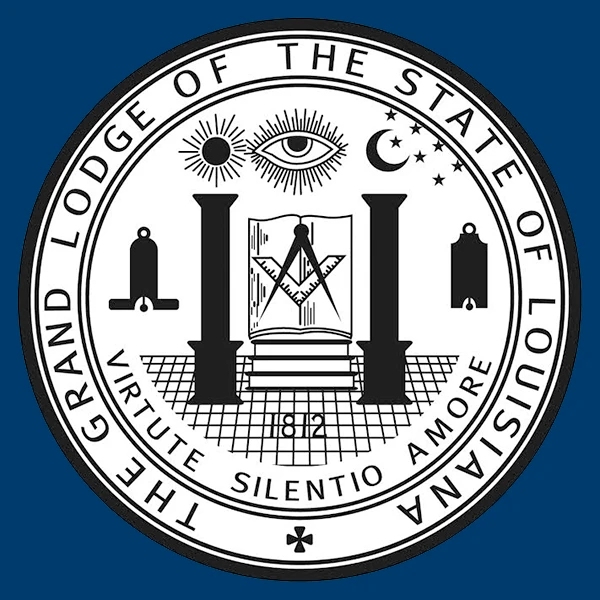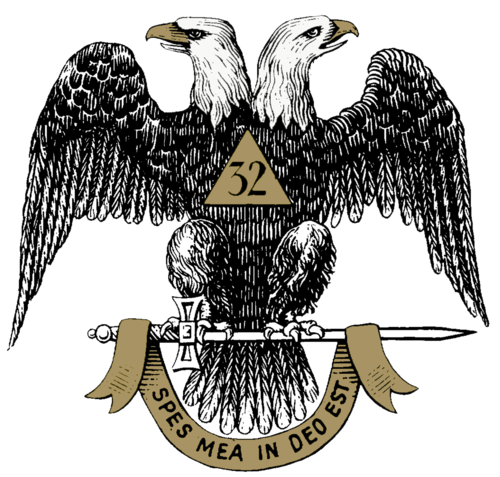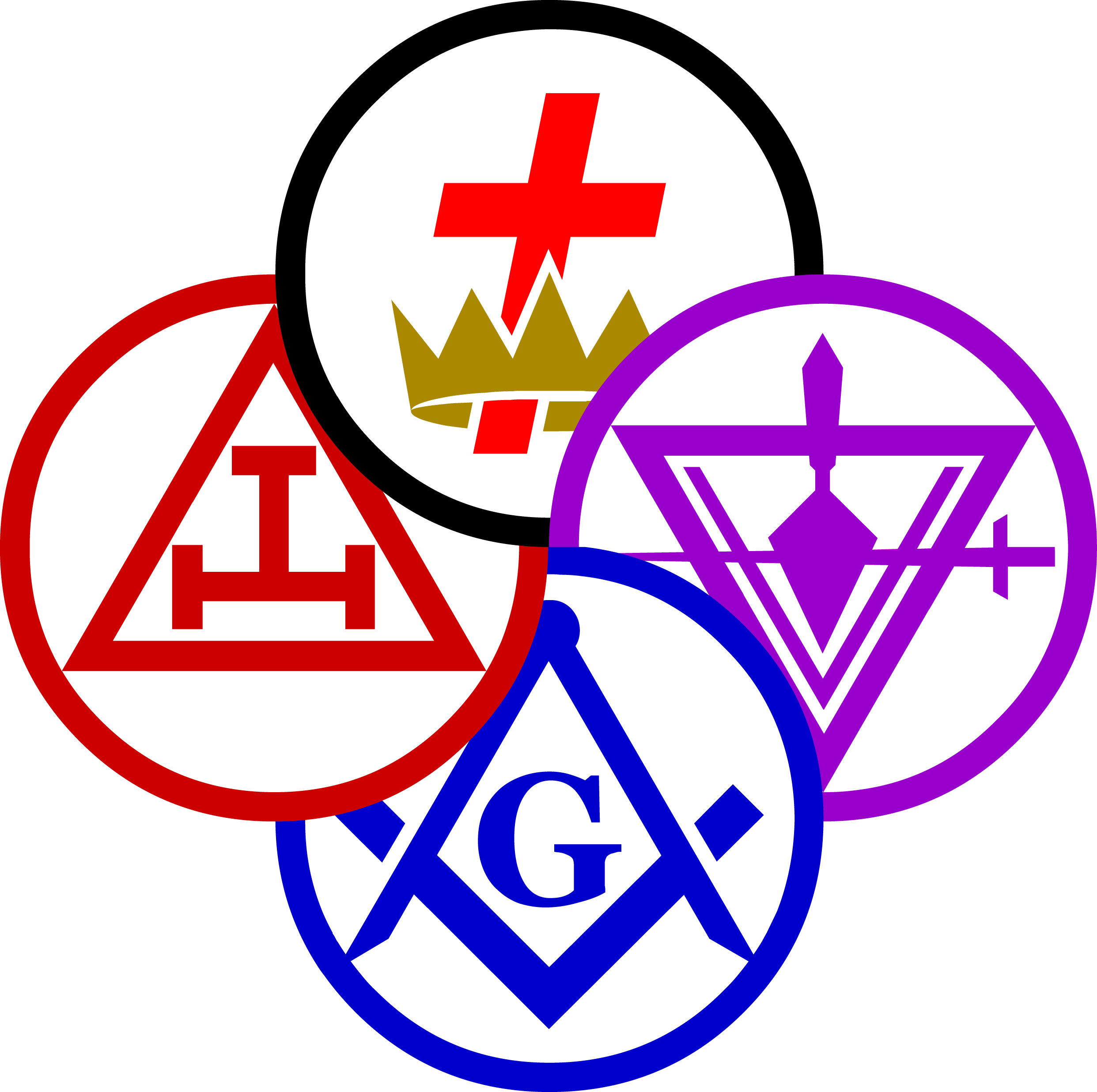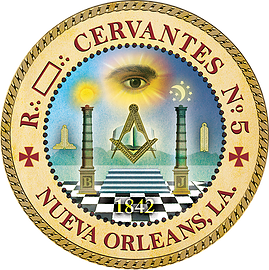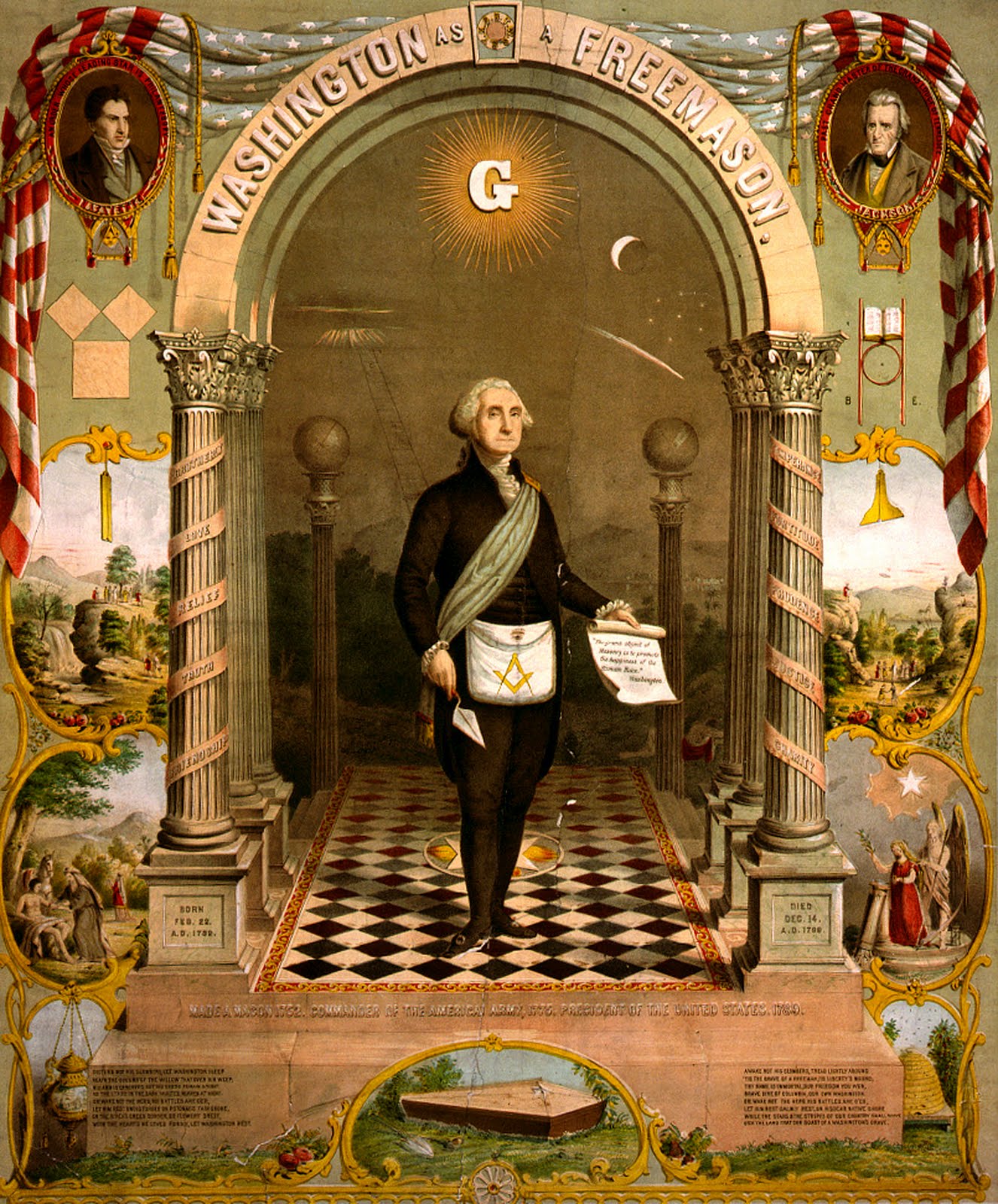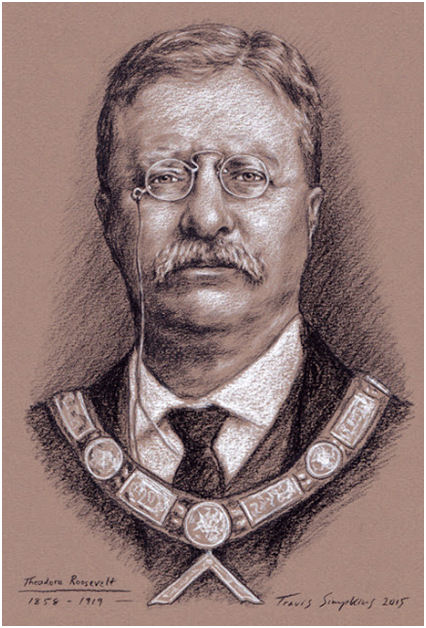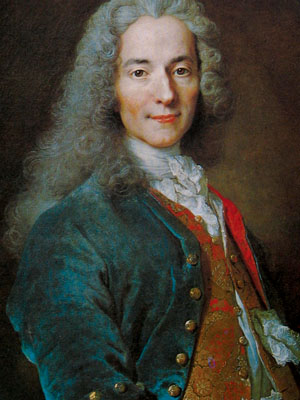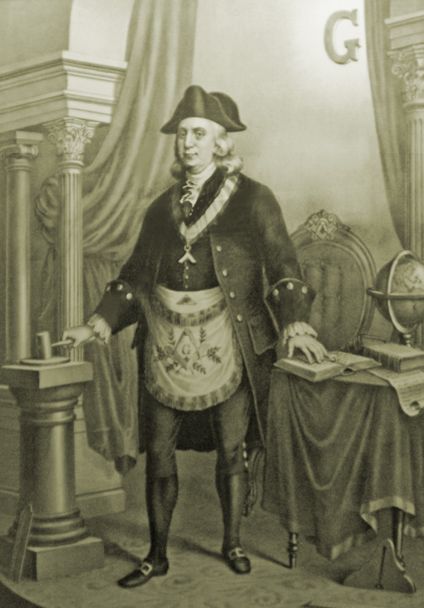History
A Brief History of Germania Lodge No. 46

The Breaking Dawn
In 1844, the population of New Orleans was approximately 103,000 composed chiefly of French descendants with a fair number of German-speaking people who had immigrated to this country to seek fame and fortune. Some of these Germans spoke French in addition to their native tongue. Those among them who were Freemasons previous to their arrival and others who became attracted to the Craft after reaching these shores were compelled to affiliate with French-speaking Lodges, for at that time there were only ten Masonic Lodges in the city, nine of these using the French language and one, the Spanish language1.
In order to perpetuate the German tongue and to afford others who spoke one language only an opportunity of being introduced to the mysteries of Freemasonry, on March 24, 1844, thirteen Brethren met in the hall of Perseverance Lodge No. 4 for the purpose of forming a German-speaking Masonic Lodge. After considerable discussion, a tentative plan for a Lodge was outlined. The meeting was adjourned to March 26, 1844. At this latter meeting, the Lodge's organization was completed with the election of officers and forwarding of a petition for a charter to the Grand Lodge of the State of Louisiana.
On April 16, 1844, they again met under the auspices of the Deputy Grand Master, who approved their credentials and organization. The Grand Lodge granted a York Rite2 charter as of that date, under the name and number of Germania Lodge No. 46, F. &. A.M. At that meeting, it was decided to write the minutes in German and French. Finally, on May 4, 1844, at the hall of Perseverance Lodge No. 4, the Grand Lodge duly constitued Germania Lodge No. 46 with full ceremony and delivered the Lodge's charter to its first Worshipful Master, Gustave Martel.
The records do not clearly state from which Lodges the organizers of Germania were drawn. We do know, however, that the majority, if not all, of them were originally members of Perseverance Lodge No. 4. This Lodge has always been considered the mother Lodge of Germania. Thus, a German-speaking offspring of French parentage was created. It survived the vicissitudes of childhood, youth, and manhood, arriving at the ripe, old age of 175 years, as of today.
The customs prevailing in 1844 were much different from those of today. For the first year, Germania met on the second and fourth Sundays of the month at nine o'clock in the morning, the meeting hour changing in March 1845 to four o'clock in the afternoon. How many Masons of the present day and time would attend a communication at that later hour during the sultry summer months? How many Secretaries would be capable of writing the minutes in three languages? Yet, we read that such was the custom at that time. During the first year, the records were written in German and French, and during the second year, in French and English. From 1846 to 1936- for 90 years - Lodge documents were written in German. Germania is perhaps the only Lodge that employed three languages in its work.
From the time of organization, Germania met in the hall of Perseverance Lodge No. 4 situated at the corner of St. Claude and Dumaine Streets. Relations between the members were most amiable and cordial, but Germania's membership was in a measure dissatisfied. Their ambition was to have a meeting place they could call their Masonic home. This question was agitated from time to time, resulting in 1845 in the purchase of a location on St. Louis Street between Derbigny and Roman Streets, consisting of three lots of ground and a two-story school house.3 At considerable expense, the building was altered and renovated, making suitable as the hall of a Masonic Lodge. For over 80 years, this building served as Germania's home.
Germania's Rising Sun
In its first 100 years, Germania continued on in a tranquil way, spreading its rays of light in Louisiana Masonry and wider society. Like all Lodges, it had its good years and years that were not so good, but as a whole it enjoyed comparitive prosperity.
Fortunately for the Lodge, Germania's early growth coincided with the largest influx of German immigration in New Orlean's history. Fleeing civil war in their homelands, mid-century German immigrants were generally drawn from the professional classes, and most settled in New Orleans. Louisiana Germans of the 1840s and 1850s were responsible for the introduction of German music, architecture, numerous breweries, churches, and theaters, as well as the building of city streets and waterworks. 53,000 German immigrants arrived in New Orleans - the nation's second-leading antebellum port of entry - in 1853 alone. Many of these late-antebellum German immigrants left Louisiana for other states, but by 1850, 25,000 Germans had made the Pelican State their adopted home.
By 1858, the Lodge boasted such a healthy financial condition that it was able to erect a tomb in Greenwood Cemetary on Metairie Ridge to afford members a dignified burial. At this time in New Orleans' history, such tombs were more than mere conveniences. In the nineteenth century, the recurring dangers of yellow fever epidemics during the warmest months made proper interment a matter of grave public necessity, for the disease frequently decimated the city's population.5 Ever generous in spirit in the midst of adversity, Germania opened its vaults to vulnerable victims of the pestilence, particularly German immigrants without means to bury loved ones.
Despite the ravages of the American Civil War and Reconstruction, Germania arranged a sumptuous celebration of its twenty-fifth anniversary in 1869. Later years found the Lodge celebrating with vereine6 and performing Masonic baptism and adoption ceremonies. Late-nineteenth century reports to the Grand Lodge indicate that attendance at meetings was always good and that the Lodge officers discharged their Masonic duties with credit to themselves and honr to the Craft.
During this period, Brothers from Germania spawned the organization of yet more Lodges. In November 1863, German-speaking members petitioned to charter Kosmos Lodge No. 171, and within a year, several members of Kosmos decided to apply to charter Union Lodge No. 172, an English-speaking Lodge. Several decades later, Union Lodge No. 172 would come to play an important role in a transitional time of Germania's history.
The year 1875 saw great material improvements to the exterior and interior of the hall, and Germania allotted space in the temple for a barroom and Masonic club owning a fine library. Sadly, in March 1879, the barroom was destroyed by flames communicated from a burning, two-story frame kichen adjoining a nearby dwelling. Nevertheless, the building was still a fine property in which visiting Brothers could enjoy a freindly and hospitable reception. In 1920, this temple was remodeled to suit the needs of the Lodge for the occasion of the 75th chartering anniversary.
Germania's venerable, old temple was sold to the City of New Orleans in 1928, but the Lodge's dream for a hall of its own did not die. Plans were set in motion while the Lodge temporarily met at its original hall (the hall of Perseverance Lodge No. 4). In 1930, the Brothers decided to build a new Lodge hall. The present location at 4415 Bienville Street was secured, and the building, erected. The Grand Lodge laid the cornerstone on July 20, 1930, with Grand Master Leon S. Haas officiating. The temple was dedicated with appropriate ceremony on December 6, 1930, and Germania has had continuous meetings there on the second and fourth Wednesdays ever since.
A Zenith of Influence
Over the course of its long history, Germania has enjoyed a diverse membership, and the Lodge has seen brewery workers, engineers, attorneys, doctors, merchants, and all manner of men cross its threshold. At the turn of the twentieth century, many of the notable men of their day and time were listed in its roster: men of every profession and walk in life, who through their achievements ebcame distinguished Masons and exemplary citizens.
Space does not permit us to mention all of them. There is one name, however, that stands out most prominently among the illustrious ones that have graced its membership. We would be lacking in our love and devotion to him if we did not give it special mention. Not only was he recognized as an outstanding practicioner of his profession and an able statesman, but he was also noted in Masonic circles for his exceptional service to the Craft in this state. We refer to our late, lamented Brother Charles F. Buck, Past Grand Master.
Brother Buck was initiated in June of 1866, passed in July, and raised in September. He served as Worshipful Master for six years from 1880 to 1885, inclusive. At the same time that he held office in Germania, Brother Buck also served as Grand Junior Warden and Grand Senior Warden. Then, in 1887 he was elected Grand Master of the Grand Lodge of the State of Louisiana, the exalted office for which he was reelected for the next five years.7 At the conclusion of his sixth term, he declined to accept the generous offer of his Brothers any further, having completed his work in the Grand Lodge. Brother Buck was so respected in Louisiana Masonry that he is the only Brother to have a Lodge named after him during his lifetime, Charles F. Buck Lodge No. 260 in Urania, Louisiana.
In addition to being an actor, Brother Buck was the city attorney for New Orleans from 1880 to 1884 and ran an unsuccessful bid for mayor. After a brilliant start as a lawyer, the call of the stage was so strong that he briefly quit the law and traveled for two years with Milton Nobles, a famous musician and comedic actor of the day. He then returned to practice law and was elected to the United States House of Representatives in 1894. An embodiement of the humble citizen-leader, Brother Buck declined to run again for office after serving only one term.
Brother Buck passed to his reward on January 19, 1918, and he was buried by the Grand Lodge with full Masonic honors, members of Germania attending en masse. Friede seiner Asche.
Dark Clouds
Following on the heels of the golden age of German-American culture was the tragedy of World War I. As such a large ethnic group, Louisiana Germans could not escape becoming a target for the anti-German hysteria and American nationalism of the War. The severity of this hysteria in Louisiana was reflected in laws passed by the Louisiana Legislature in 1918. Under these laws, teaching the German language in public, parochial, and private schools, colleges, and other institutions in the state was prohibited, as was printing any material in German. Flying the German flag, selling and exhibiting German-made products, and even conveying books written in German also became illegal acts punishable by fines and prison sentences of up to ten years.9 These draconian laws obviously struck a blow to the German heritage in Louisiana, as they eliminated German instruction in educational institutions and forced German organizations, businesses, and religious congregations to disband, go underground, or assume a more orthodox "American" identity. Despite the intolerance, Germania survived and enjoyed modest growth during the 1920s, a decade of recovery and rebuilding after the Great War.
The darkest pages of Germania's history are those written during the years 1928 to 1936, a time of intense economic and cultural adversity and corresponding adaptation.
During these perilous years, the Lodge managed to survive solely due to the loyalty and liberality of its officers and a few financially able Brethren. Burdened with the obligations of meeting deficits from month to month, harassed by the knowledge that their investments would be lost through the crash of the financial institutions to which they were entrusted, and fearing the imminent danger of losing the Lodge hall through foreclosure proceedings, Brothers during the Great Depression overcame circumstances that would have been sufficient to break the spirit of any ordinary body of men. In spite of all handicaps and reverses, these faithful and loyal members decided to carry on to the bitter end, even at the sacrifice of their last dollar of personal resources. In the fate of great difficulties, our forefathers were successful: the temple was saved and within the Lodge, for had the building been lost, the humiliation would have been too great, and Germania would have been crushed to earth, never to rise again as a Masonic Lodge. Thanks to their efforts, Germania is today one of only two Lodges with their own buildings left in the city limits of New Orleans.
Various factors around this time coalesced and caused a gradual decrease in the available pool of German-speaking members. Beginning in 1924, more restrictive immigration policies exacerbated the lack of Germanophobe inhabitants in the city. Coupled with the passing of some of the older Brothers to the celestial Lodge above, Germania experienced a slow but steady decline in membership. The effects of the Great Depression only made the situation worse by forcing the Lodge on account of its own financial embarrassment to drop from its rolls Brothers who could not pay dues.
By 1934, it was evident that Germania could not continue to exist using German exclusively. The Lodge decided to accept applicants for degrees in German and English. Reception of the first petition, instead of bringing the expected relief, only increased Germania's woes. The candidate could not speak a word of German, and the officers were not proficient in English. What could be done? Fortunately, Union Lodge No. 172 came to Germania's rescue by conferring courtesy work. To this day, Germania owes Union a great deal of gratitude for their aid in turbulent times.
In February 1934, the Lodge finaly decided to transfer to the English language. In order to carry on the tradition of using German, however, the Lodge voted to open and close in German, all other work to be done in English. At the occasion of the 100th anniversary in 1944, the Lodge opened in German and closed in English. Thereafter, Germania has continued the practice of working in English except on certain special occasions and for opening and closing prayers.
After avoiding foreclosure and changing languages, dark prospects still lay on the horizon. World War II proved a particularly trying time. As with other German-American organizations, warfare created suspicion of sympathies, which caused internal strife. While politcal sentiments and doubts of patriotism were never discussed in Lodge, they did have a negative effect. Nevertheless, the year 1936 was the turning point in Germania's downward direction, and since then, the Lodge has continued progress, ever remembering the suffering and hardships endured by Brothers of yore.
Basking in Light
The postwar years occasioned financial stability and new opportunities for the Lodge, and the period is marked by its almost idyllic and unremarkable course. Returning soldiers embraced Masonry, and membership reached an all-time high of 150 members. The temple served as the venue of many a wedding and reception, and the first air conditioning units were installed in the late 1950s. Germania soon hosted weekly teenage dances, and some of the most popular musicians of the era, like Irma Thomas, Ernie K-Doe, Benny Spellman, and Mike and the Jokers, performed on the Lodge's dance floor. Oktoberfest parties in the fall and crawfish boils in the spring completed the Lodge's calendar of rollicking social events.
The early- and mid-1960s brought renovations and paneling to the interior of the Lodge room and the social hall. Until the 1970s, the building adjacent to the temple (at 4417 Bienville Street) served as a bowling alley solely for the use of Lodge members. Today, this neighboring building contributes to Germania's treasury as a rental space.
Despite the Lodge's warm conviviality, full coffers, and long roster, trends of decline affecting all parts of Masonry began to manifest in Germania. The anti-establishment culture of the 1960s and 1970s, coupled with long-term shifts in the labor market and a greater array of leisure activities, worsened the natural loss of membership. Fewer men were stepping forward to petition the Lodge, and Germania was faced with the existential challenge posed to the Craft as a whole. Still, if the present is any sure indication, it appears that the Lodge planned its reaction to this trend prudently and wisely.
Glimmers from an Historic Ritual
One of the most curious and elusive parts of Germania's history has been the story of its German-language ritual, manuscript copies of which were discovered in the Lodge archives in February 1993. Thanks to the astute scholarship and diligent investigation of Worshipful Brother Arturo de Hoyos, an honorary member of Germania, some of the mysteries of the Lodge's earlier ritual have been unlocked.
What follows is a condensation of Worshipful Brother de Hoyo's research.
Germania Lodge No. 46 left no records concerning fons et origo of their German-language ritual, and unfortunately, many questions of its provenance remain: By whom was it written or translated? Had a ritualistic committee been appointed, or was it the work of an individual? Was it a translation of the ritual then in use by Perseverance Lodge No. 4, and was the ritual indeed a "German (language) offspring of French parentage"? Or, if the ritual had Germania roots, from where did it come? From what system or rite did it derive? Did it differ materially from the English-language "Scottish Rite Blue Lodge" ritual adopted adopted by Germania in 1940? While some of these questions are still not entirely answered, research has uncovered more of the nature of Germania's old ritual.
Germania's original German-language ritual is a hybrid of Scottish Rite Craft Masonry and early New York State Masonry.10 Much of the ritual follows (often verbatim) the text exposed by William Morgan in his Illustrations of Masonry11 Still, although Morgan's exposé of the Preston-Webb ritual served as the foundation for Germania's ritual, it is not a slavish copy of Morgan's work, and the differences between the two texts hint at aspects of the compiler's identity.
While the ritualist(s) responsible for Germania's ritual occasionally corrected errors present in Morgan's work and attempted to Germanize the spelling of words, he or they seem to have been unfamiliar with German Masonic terminology. Moreover, Germania's ritual consistently follows Morgan's American modes of recognition rather than those of European Germanic rituals. Taken together, these details suggest that the ritualist(s) of Germania's original ritual received his or their Masonic degrees in America and not in Europe.
The ritual's compound nature is reiterated in its public ceremonies. The ceremony of Masonic baptism is a uniquely European ceremony practiced in some French and German Lodges and imported to the United States in the mid-nineteenth century.12 On the other hand, Germania's old burial ceremony is strikingly similar to those included in James Page's 1856 Freemason's Monitor and Albert G. Mackey's 1862 Manual of the Lodge (both based on William Preston's Illustrations of Masonry).
Ironically, although Germania abandoned its German-language ritual in 1940, the Lodge's ritualistic hybridity survies even to this day, for Germania's current ritual is an amalgam of Jacques Foulhouze's 1861 Scottish Rite Craft Lodge ritual and Louisiana's York Rite work.
Broader Horizons
Germania's recent past has exemplified the constant theme running throughout its history: balancing the ideals of tradition and continuity with the demands of change and accomodation. The Lodge has seen its Masonic impact expand both near and far and has made forays into new fields of communication and cultural promotion. A catastrophic natural disaster tested the Lodge's resolve to survive, but even while battered by the forceful waves of time, Germania, rock-like, has stood steadfast.
Beginning in the late 1990s, Germania forged ties of brotherly love with members of York Rite Lodges in Louisiana and beyond. In the progress, the Lodge became an unofficial ambassador of Scottish Rite Craft Masonry to the wider world.
Since 1998, Germania has held joint communications with Indivisible Friends Lodge No. 404 of Gretna. The two Lodges alternate both the place of meeting and the performance of the opening and closing ceremonies. In this way, members of Germania have been exposed to some York Rite work, while members of Indivisible Friends have experienced some Scottish Rite work. The result of this exchange has been to bring Brothers together who otherwise never would have sat in Lodge with one another.
Today, Germania's friendly interaction with other Lodges encompasses areas all over the state and country. Germania's degree work has been impressive enough that a traveling Germania degree team was formed in 1998 to exemplify the Scottish Rite degrees. The first trip was to Denver Lodge No. 5 in 1999, and today an annual tradition of visiting Brothers in Denver thrives. The Germania degree team was renamed the 16th District Traveling Degree Team a few years ago better to represent our unique ritual and District, but the paraphenalia used for the degrees and most of the team's members belong to Germania. The team has exemplified ritual work in Des Moines, Iowa; Chicago, Illinois; Macon, Georgia; and Pensacola, Florida, to name a few cities.
The Lodge has also made a significant effort to keep up with the modern age of the Internet and social media with a shift away from newsletters to other means of communication. The early 2000s saw the advent of the Lodge's use of email and the management of a website. Later in the decade, the Lodge created a Facebook page to advertise upcoming events. Such technological innovations have not only made administration of the Lodge affairs far more efficient, but they have also attracted the eyes of potential candidates and broadened public awareness of Germania.
Germania has also lately experienced a revival in the promotion and preservation of its German heritage. Since 1999, the Lodge has held a Germanfest soon after the Deutsches Haus's Oktoberfest in order to open the Lodge's doors to fellow German-Americans and the public at large. In 2000, Germania entered into a long-term loan with the Historic New Orleans Collection to safeguard intact minutes, Treasurer's reports, membership roster, and other old manuscripts for the use of researchers and future generations of Brothers. These efforts have brough the Lodge even closer to the heart of New Orleans' German-American community and perpetuated a past worthy of study and admiration.
Yet, even in the midst of so much progress, cruel circumstance was to intervene. The year 2005 was the darkest since the Great Depression, for in both periods, the Lodge nearly lost its temple building. In late August of that year, the worst hurricane to hit the city in generations wrought unspeakable destruction and havoc across the Gulf Coast. Hurricane Katrina felled nearby trees, tore off roof tiles, and innundated the temple with more than three feet of water. Upon entering the building for the first time after two weeks of sweltering heat and no electricity, Worshipful Brother Klaus J. Kueck was devastated at the sight of ruined furniture and appliances and doubted whether Germania would survive such vast flooding and damage. Indeed, the Lodge had never carried flood insurance in its history.
Despite the numerous obstacles, Germania proved its resilience and rebuilt. Many Brothers spent countless hours at the temple tearing out the old and installing the new. The Lodge used all of its savings and financial resources to replace electrical units, sheetrock, air conditioners, and countless other necessities. Finally, after holding communications at the hall of Square and Compass No. 417 for a while, Germania returned to its beloved building permanently.
Satisfied with the results downstairs and having a little money left due to a substantial number of donations, Brothers shifted their attention to the Lodge room upstairs. After untold hours of toil and hard work, the Lodge room was completely renovated and entirely new Lodge furniture was secured. Today, the only original pieces left in the Lodge room are the statue of King Solomon and the chars in officers' stations.
Despite Hurricane Katrina's destruction or perhaps because of the spirited recovery effort in response to it, the Lodge's last 25 years have seen its membership increase to heights not encountered since the 1950s, recently reaching 122 members. With more young members and involved families, Germania is currently experiencing a noticable period of growth, one which will hopefully sustain it for unnumbered years to come.
Throughout its history, Germania has embodied and proved to the outside world the true universality of Masonry. Being made up for the most part of members who are of foreign descent, the Lodge exemplifies in an outstanding manner just what Freemasonry can do and has done in affecting the lives of all peoples, regardless of nationality or creed. The fine Masonic spirit prevailing in the Lodge causes one to observe that Freemasonry, if brought into the homelands of all peoples, could be a powerful infulence in molding the thoughts and actions of a people into a more wholesome recognition of the principles of the brotherhood of man. With these continued blessings of the Grand Architect of the Universe and the unity of the Brothers, Germania advances in its march ever onward and upward until it shall have regained and surpassed its former glory. Our hope and prayer is that the membership will cherish and revere the priceless heritage left to them as much as we, the present members, love and esteem the traditions of our founders of 175 years ago.
Footnotes
1 Only five of the eleven Lodges in the city in 1844 survive today:
Perfect Union Lodge No. 1
Etoile Polaire Lodge No. 1
Perseverance Lodge No. 4
Cervantes Lodge No. 5 (then Los Amigos del Orden Lodge No. 5)
Germania Lodge No. 46
2 Although the Lodge's charter was in the York Rite, the charter permitted cumulation of the Scottish and French Rites.
3 The address of the Lodge's first temple of its own was first designated as 518 St. Louis Street and later as 1824 St. Louis Street.
4 The cumulative effect of this surge of immigration made New Orleans a center of German-American culture and social activity before World War I. Between the years of 1848 and 1900, Germans were the largest foreign-language-speaking group in Louisiana. By the year 1850, fully one-fifth of Louisiana's population spoke German as its primary language, and there were more than fifty German-speaking newspapers and journals published in the state. By the early 1900s, there were over 250 German-American societies in the state, mainly in New Orleans, with Germans making up about twelve percent of the state's population. German-language schools as well as in private and parochial schools maintained by German-American secular and religious institutions.
5 The worst such yellow fever epidemic in New Orleans occured from July to October 1853. Ultimately, the contagion claimed almost 7,900 lives and earned the city the nickname "Necropolis," meaning "city of the dead." Yellow fever epidemics struck newly-arrived European immigrants with particular severity, given their unacclimated immune systems.
6 These voluntary associations were dedicated to the promotion of German culture; to providing aid to the indigent; and to assisting Germans with immigration, assimilation, and naturalization. To date, Germania continues to foster close ties with similar German organizations in the New Orleans area, including the Deutsches Haus and the Schlaraffia.
7 Brother Buck is not the only member of Germania to govern the Craft in Louisiana. In 2018, Most Worshipful Brother Martin J. Reinschmidt, P.M., became the second member of Germania to sit the Grand East.
8 "May his ashes rest in peace."
9 Germania was not spared from the influence of external anti-German sentiment. For example, in 1917, it was openly debated in Germania whether a Brother who was a German citizen in naturalization proceedings but still classified as an alien enemy could be elected and installed as Worshipful Master of the Lodge. The Proceedings of the M.W.Grand Lodge, Free and Accepted Masons, of the State of Louisiana (New Orleans, A. W. Hyatt, 1918), p.52
10 Worshipful Brother de Hoyo's conclusions support the long-recorded, but little-known, fact of Germania's mixed ritual. See Proceedings of the M.W. Grand Lodge of the State of Louisiana, Free and Accepted Masons (New Orleans, Clark & Hofeline, 1875). ("Germania Lodge works the first degree in the A. and A. Rite, the second and third degree, in the York Rite, or as taught by the Grand Lodge." Ibid., 52)
11 William Morgan, Illustrations of Masonry by One of the Fraternity who has Devoted Thirty Years to the Subject (Utica, William C. Miller, 1826).
12 Indeed, if the ceremony of Masonic baptism included in Germania's manuscript ritual is contemporary with the founding of Germania Lodge No. 46 in 1844, it is the oldest known version of the ceremony in the United States.

